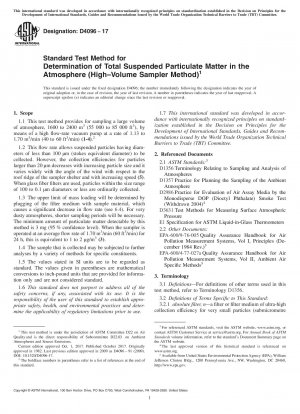ASTM D4096-17
Standard Test Method for Determination of Total Suspended Particulate Matter in the Atmosphere (High–Volume Sampler Method)
- Standard No.
- ASTM D4096-17
- Release Date
- 2017
- Published By
- American Society for Testing and Materials (ASTM)
- Status
- Replace By
- ASTM D4096-17(2023)
- Latest
- ASTM D4096-17(2023)
- Scope
- 1.1 This test method provides for sampling a large volume of atmosphere, 1600 to 2400 m3 (55 000 to 85 000 ft3 ), by means of a high flow-rate vacuum pump at a rate of 1.13 to 1.70 m3 /min (40 to 60 ft3 /min) (1-4).2 1.2 This flow rate allows suspended particles having diameters of less than 100 µm (stokes equivalent diameter) to be collected. However, the collection efficiencies for particles larger than 20 µm decreases with increasing particle size and it varies widely with the angle of the wind with respect to the roof ridge of the sampler shelter and with increasing speed (5). When glass fiber filters are used, particles within the size range of 100 to 0.1 µm diameters or less are ordinarily collected. 1.3 The upper limit of mass loading will be determined by plugging of the filter medium with sample material, which causes a significant decrease in flow rate (see 6.4). For very dusty atmospheres, shorter sampling periods will be necessary. The minimum amount of particulate matter detectable by this method is 3 mg (95 % confidence level). When the sampler is operated at an average flow rate of 1.70 m3 /min (60 ft3 /min) for 24 h, this is equivalent to 1 to 2 µg/m3 (3). 1.4 The sample that is collected may be subjected to further analyses by a variety of methods for specific constituents. 1.5 The values stated in SI units are to be regarded as standard. The values given in parentheses are mathematical conversions to inch-pound units that are provided for information only and are not considered standard. 1.6 This standard does not purport to address all of the safety concerns, if any, associated with its use. It is the responsibility of the user of this standard to establish appropriate safety, health, and environmental practices and determine the applicability of regulatory limitations prior to use. 1.7 This international standard was developed in accordance with internationally recognized principles on standardization established in the Decision on Principles for the Development of International Standards, Guides and Recommendations issued by the World Trade Organization Technical Barriers to Trade (TBT) Committee.
ASTM D4096-17 Referenced Document
- ASTM D1356 Standard Terminology Relating to Sampling and Analysis of Atmospheres*, 2024-04-22 Update
- ASTM D1357 Standard Practice for Planning the Sampling of the Ambient Atmosphere*, 2019-08-01 Update
- ASTM D2986 Standard Practice for Evaluation of Air Assay Media by the Monodisperse DOP (Dioctyl Phthalate) Smoke Test (Withdrawn 2004)
- ASTM D3631 Standard Test Methods for Measuring Surface Atmospheric Pressure
- ASTM E1 Standard Specification for ASTM Thermometers
ASTM D4096-17 history
- 2023 ASTM D4096-17(2023) Standard Test Method for Determination of Total Suspended Particulate Matter in the Atmosphere (High–Volume Sampler Method)
- 2017 ASTM D4096-17(2017) Standard Test Method for Determination of Total Suspended Particulate Matter in the Atmosphere (High–Volume Sampler Method)
- 1991 ASTM D4096-91(2009) Standard Test Method for Determination of Total Suspended Particulate Matter in the Atmosphere (High-Volume Sampler Method)
- 1991 ASTM D4096-91(2003) Standard Test Method for Determination of Total Suspended Particulate Matter in the Atmosphere (High-Volume Sampler Method)
- 1997 ASTM D4096-91(1997)e1 Standard Test Method for Determination of Total Suspended Particulate Matter in the Atmosphere (High-Volume Sampler Method)
